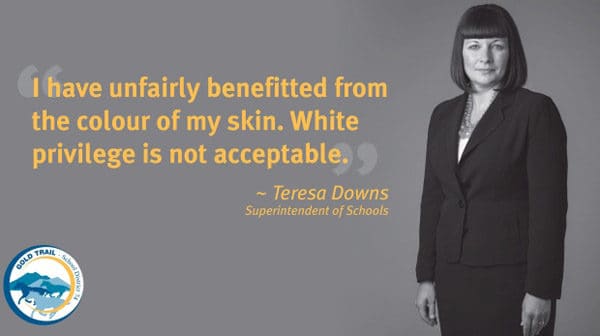Poster in B.C. Schools About White Privilege Hits Nerve with Some Parents
The Canadian Press, March 9, 2018
A poster campaign at a school district in British Columbia’s Interior aimed at creating conversations about racism and privilege has struck a nerve with some parents.
Schools in the Gold Trail District hung up the posters featuring officials sharing their experiences with racism in January, but a comment about “white privilege” has some parents now questioning the purpose of the campaign.
The poster at the centre of the debate features a photo of district superintendent Teresa Downs next to her quote that reads: “I have unfairly benefited from the colour of my skin. White privilege is not acceptable.”

Kansas Field Allen, whose son is a Grade 9 student at Kumsheen Secondary School in Lytton, said singling out one racial group is a disservice to blended families.
Her husband is Aboriginal, as are their children, and she said since the posters went up, one person told her as a white person she should feel uncomfortable around her family.
She said she’s also heard of at least one child who said they felt ashamed for being white.
“Racism is alive out there and our kids do need to learn about it, but they need to learn about it at an age appropriate level and they don’t need to learn about one race over another,” she said. “Let’s talk to the students and see if we can do this in a better way, a more accepting way.”
Other posters feature district staff and comment on experiencing and needing to confront racism.
Downs said the campaign fits into ongoing efforts to discuss inequality in schools and her comments about white privilege are a reflection of her own experience.
“We understand that the discussion of race and privilege can make some people feel uncomfortable,” she said in an interview. “But we are also mindful in this district that we cannot have a wholesome conversation about racism without acknowledging that racism results in some groups being privileged.”
The district serves about 1,100 students across rural communities and First Nations territories west of Kamloops. About 60 per cent of students identify as having Indigenous ancestry, Downs said.
For many years, Downs said the district has been tackling issues of racism and colonialism, and has worked to follow recommendations by the Truth and Reconciliation Commission.
The poster campaign was inspired by similar billboards created by the City of Saskatoon last year, Downs said, and seen as an important next step from previous efforts within the district to advance discussions about inclusion.
“We work very hard to make the conversation not about individuals but our systems and our societies,” she said.
The posters have gone largely undisputed by students and the community, Downs said. In some schools, students have on their own created “Got privilege?” posters to add to the campaign.
Downs said part of the more recent criticism appears to stem from parents struggling with the term privilege.
Some comments on social media have suggested Downs doesn’t think she’s worked hard to earn her role in the community or is discrediting other white people who do struggle socially or economically, she said.
“I’m not saying that at all,” she said. “The definition of privilege here doesn’t mean high social status but just the acknowledgment that things in our society are at times easier for those who have white skin.”
Darren Lund, an education professor at the University of Calgary, said this type of backlash is not uncommon and people often prefer to stick with “colour blind” discourse, thinking that ignoring inequality and hierarchies is the way to move past it.
But he said acknowledging and discussing privileges, such as never being asked “where are you really from” as a white Canadian, is the more effective way to push back against structures that support those stereotypes.
In an era where children are seeing communities rally against inequality and support emerging for the #MeToo campaign, Lund said schools have an opportunity to bring the discussion into the classroom.
“Young people are very articulate and very sensitive to topics like this and it’s only by putting issues like this on the table, issues like racism, sexism, homophobia and privileges, that we can move forward together,” he said.















